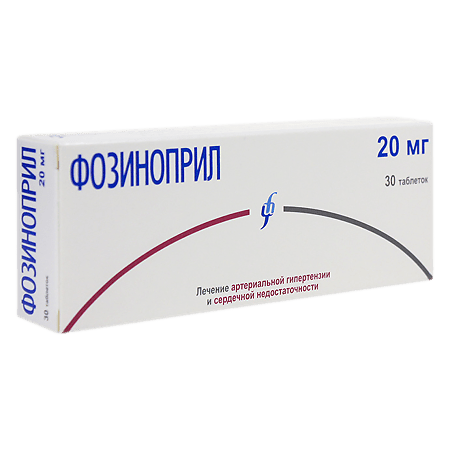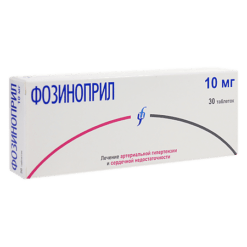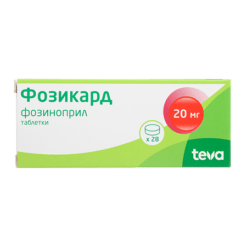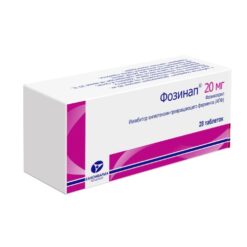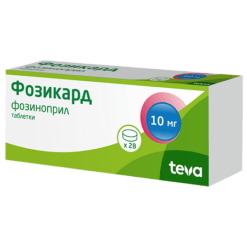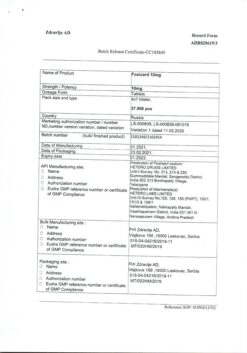No products in the cart.
Fosinopril, tablets 20 mg 30 pcs
€14.35 €11.96
Description
Pharmgroup:
A ACE inhibitor.
Pharmic action:
The ACE inhibitor, has hypotensive, vasodilatory, diuretic and potassium-saving effects. Reduces the formation of angiotensin II from angiotensin I, which leads to a decrease in RPS and systemic BP.
Suppresses aldosterone synthesis and inhibits tissue ACE.
The hypotensive effect is also due to inhibition of bradykinin metabolism, which has a pronounced vasodilator effect. Decrease of AP is not accompanied by changes in CBC, cerebral and renal blood flow, blood supply of internal organs, skeletal muscles, skin, myocardial reflex activity.
In hypertension and LV hypertrophy, treatment leads to a decrease in its mass and septal wall thickness. Long-term treatment does not lead to metabolic disturbances.
After oral administration, the hypotensive effect develops within 1 h, reaches a maximum after 3-6 h and lasts for 24 h.
Pharmacokinetics:
Absorption – 36% (regardless of ingestion). In the gastrointestinal mucosa and the liver is hydrolyzed to form fosinoprilat. TCmax – 3 hours, T1/2 – 11.5 hours.
Protein binding in plasma is 95%, it has relatively low volume of distribution and is poorly sorbed by cellular components.
It does not pass through the BBB. It is excreted with the bile, with the urine.
Indications
Indications
Arterial hypertension, CHF.
Pharmacological effect
Pharmacological effect
Pharmaceutical group:
ACE inhibitor.
Pharmaceutical action:
An ACE inhibitor, has a hypotensive, vasodilating, diuretic and potassium-sparing effect. Reduces the formation of angiotensin II from angiotensin I, which leads to a decrease in peripheral vascular resistance and systemic blood pressure.
Suppresses aldosterone synthesis, inhibits tissue ACE.
The hypotensive effect is also due to the suppression of the metabolism of bradykinin, which has a pronounced vasodilating effect. A decrease in blood pressure is not accompanied by changes in blood volume, cerebral and renal blood flow, blood supply to internal organs, skeletal muscles, skin, or reflex activity of the myocardium.
For hypertension and left ventricular hypertrophy, treatment leads to a decrease in its mass and the thickness of the septal wall. Long-term treatment does not lead to metabolic disorders.
After oral administration, the hypotensive effect develops within 1 hour, reaches a maximum after 3-6 hours and persists for 24 hours.
Pharmacokinetics:
Absorption – 36% (regardless of food intake). In the mucous membrane of the gastrointestinal tract and liver, it is hydrolyzed to form fosinoprilat. TCmax – 3 hours, T1/2 – 11.5 hours.
Bonding with plasma proteins is 95%, has a relatively small volume of distribution and is to a small extent sorbed by cellular components.
Does not penetrate the BBB. Excreted in bile and urine.
Special instructions
Special instructions
Patients with malignant arterial hypertension or concomitant decompensated CHF should begin treatment in a hospital setting.
Before starting therapy with ACE inhibitors and during treatment, count the total number of leukocytes and determine the leukocyte formula (once a month in the first 3-6 months of treatment and at periodic intervals up to 1 year in patients with an increased risk of neutropenia: with impaired renal function, systemic connective tissue diseases, in those receiving high doses), as well as at the first signs of infection.
Before and during treatment, monitoring of blood pressure, renal function, plasma K+ concentration, Hb and creatinine, urea, electrolyte concentrations and the activity of liver enzymes in the blood is necessary.
Based on the results of epidemiological studies, it is assumed that the simultaneous use of ACE inhibitors and insulin, as well as oral hypoglycemic drugs, can lead to the development of hypoglycemia. The greatest risk of development is observed during the first weeks of combination therapy, as well as in patients with impaired renal function. Patients with diabetes require careful glycemic control, especially during the first month of ACE inhibitor therapy.
Caution must be exercised when prescribing to patients on a low-salt or salt-free diet (increased risk of hypotension).
Safety and efficacy in pediatric practice: Close monitoring for hypotension, oliguria and hyperkalemia is recommended for neonates exposed in utero to ACE inhibitors.
Neonates and infants are at risk of oliguria and neurological disorders, possibly due to decreased renal and cerebral blood flow due to the decrease in blood pressure caused by ACE inhibitors; Lower initial doses and close monitoring are recommended.
Care must be taken when driving vehicles or performing other work that requires increased attention, because dizziness is possible, especially after the initial dose of an ACE inhibitor in patients taking diuretic drugs.
Caution should be exercised when exercising or in hot weather due to the risk of dehydration and decreased blood pressure due to decreased fluid volume.
Before surgery (including dentistry), it is necessary to warn the surgeon/anesthesiologist about the use of ACE inhibitors.
When using ACE inhibitors in the II-III trimesters of pregnancy, oligohydroamnion, hypotension of the fetus and newborn, oliguria and death are possible.
Active ingredient
Active ingredient
Fosinopril
Composition
Composition
Fosinopril 20 mg.
Contraindications
Contraindications
Hypersensitivity to fosinopril, pregnancy, lactation.
With caution. History of angioedema during therapy with ACE inhibitors, hereditary or idiopathic angioedema, aortic stenosis,
cerebro- and cardiovascular diseases (including cerebrovascular insufficiency, ischemic heart disease, coronary insufficiency),
severe autoimmune systemic connective tissue diseases (including SLE, scleroderma),
inhibition of bone marrow hematopoiesis,
diabetes mellitus, hyperkalemia,
bilateral renal artery stenosis, stenosis of the artery of a solitary kidney,
condition after kidney transplantation,
liver failure, Na+-restricted diet, conditions accompanied by a decrease in blood volume (including diarrhea, vomiting),
elderly age, age under 18 years (safety and effectiveness of use have not been studied).
Side Effects
Side Effects
From the cardiovascular system: decreased blood pressure, orthostatic collapse, tachycardia, palpitations, arrhythmias, angina pectoris, myocardial infarction.
From the urinary system: development or worsening of chronic renal failure, proteinuria.
From the nervous system: stroke, cerebral ischemia, dizziness, headache, weakness; when used in high doses – insomnia, anxiety, depression, confusion, vestibular disorders, paresthesia.
From the senses: hearing and vision impairment, tinnitus.
From the digestive system: nausea, intestinal obstruction, pancreatitis, hepatitis, cholestatic jaundice, abdominal pain, vomiting, dyspepsia, constipation, loss of appetite, stomatitis, glossitis.
From the respiratory system: dry cough, pulmonary infiltrates, bronchospasm, shortness of breath, rhinorrhea, pharyngitis, dysphonia.
Allergic, toxic-allergic and immunopathological reactions, incl. angioedema of the small intestine (very rare).
Laboratory indicators: hypercreatininemia, increased urea concentration, increased activity of “liver” transaminases, hyperbilirubinemia, hyperkalemia, hyponatremia; decreased Hb and hematocrit, neutropenia, leukopenia, eosinophilia, increased ESR.
Cases of hypoglycemia have been reported in patients with diabetes mellitus who took insulin and oral hypoglycemic drugs.
Teratogenic, fetotoxic effect – impaired development of fetal kidneys, decreased blood pressure in the fetus and newborns, impaired renal function, hyperkalemia, cranial hypoplasia, oligohydramnios, contracture of the limbs, cranial deformation, pulmonary hypoplasia.
Interaction
Interaction
Strengthens the hypoglycemic effect of sulfonylurea derivatives, insulin, and the risk of developing leukopenia when used simultaneously with allopurinol, cytostatic drugs, immunosuppressants, procainamide.
When taken simultaneously with Li+ drugs, an increase in its concentration in the blood is observed.
Antihypertensives, diuretics, narcotic analgesics, drugs for general anesthesia enhance the hypotensive effect. NSAIDs and table salt weaken the effect.
K+ drugs, potassium-sparing diuretics (amiloride, spironolactone, triamterene) increase the risk of developing hyperkalemia.
NSAIDs, incl. selective COX-2 inhibitors and estrogens (fluid retention) may reduce the severity of the hypotensive effect.
With the simultaneous use of ACE inhibitors and gold preparations (sodium aurothiomalate), a symptom complex has been described, including facial flushing, nausea, vomiting and decreased blood pressure.
Insulin and oral hypoglycemic drugs – the risk of developing hypokalemia.
Overdose
Overdose
Symptoms: decreased blood pressure, bradycardia, shock, water-electrolyte imbalance, acute renal failure, stupor.
Treatment: place the patient in a “lying” position with his legs elevated.
In mild cases of overdose – gastric lavage, administration of adsorbents and sodium sulfate within 30 minutes after administration.
When blood pressure decreases – intravenous administration of catecholamines, angiotensin II; for bradycardia – use of a pacemaker.
It is not excreted during hemodialysis.
Manufacturer
Manufacturer
Izvarino Pharma, Russia
Additional information
| Manufacturer | Izvarino Pharma, Russia |
|---|---|
| Medication form | pills |
| Brand | Izvarino Pharma |
Other forms…
Related products
Buy Fosinopril, tablets 20 mg 30 pcs with delivery to USA, UK, Europe and over 120 other countries.

